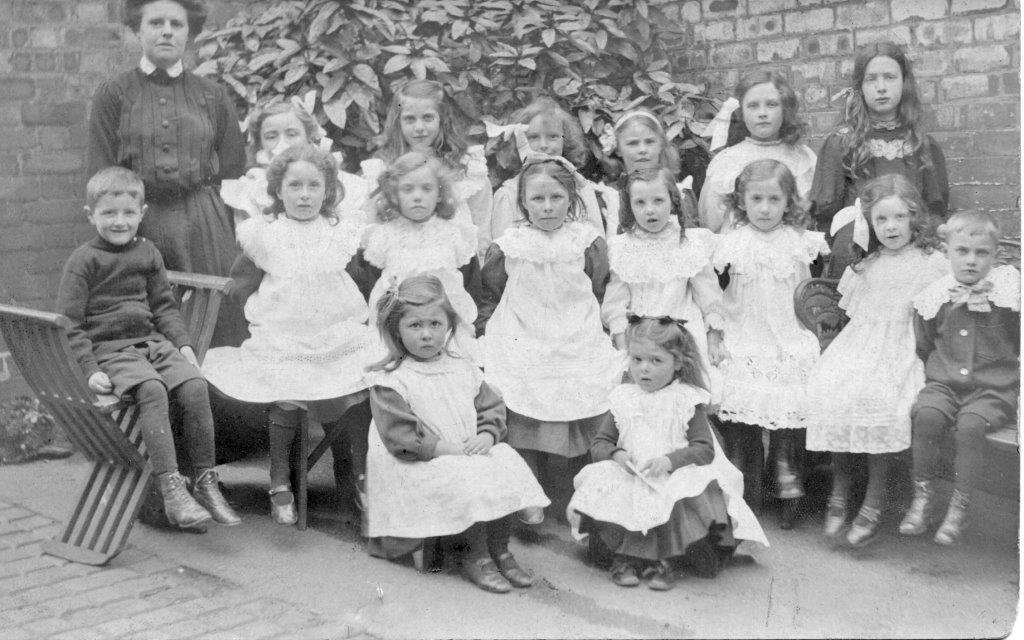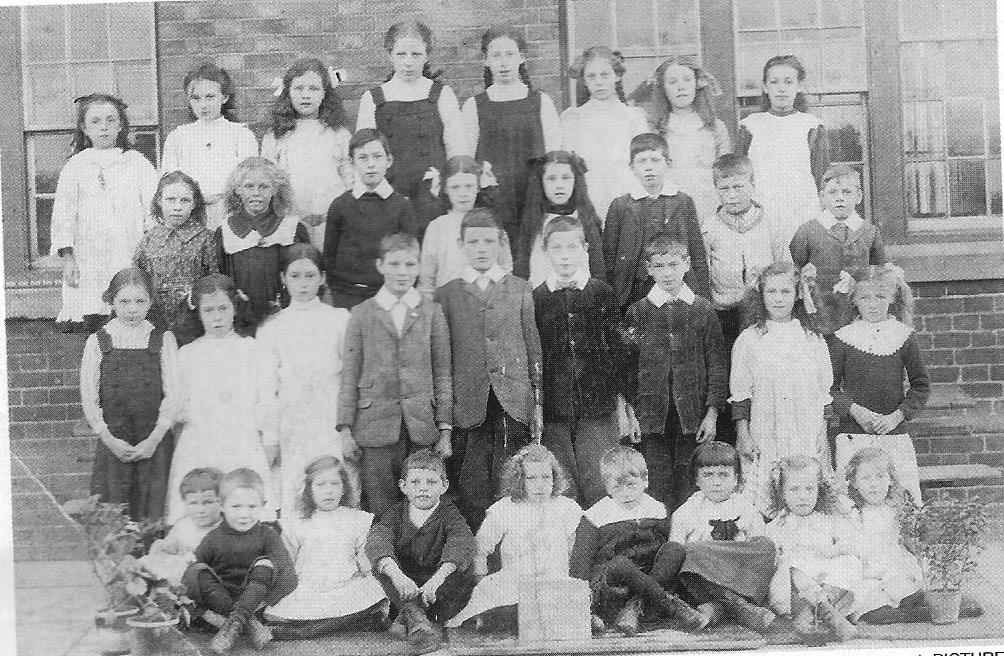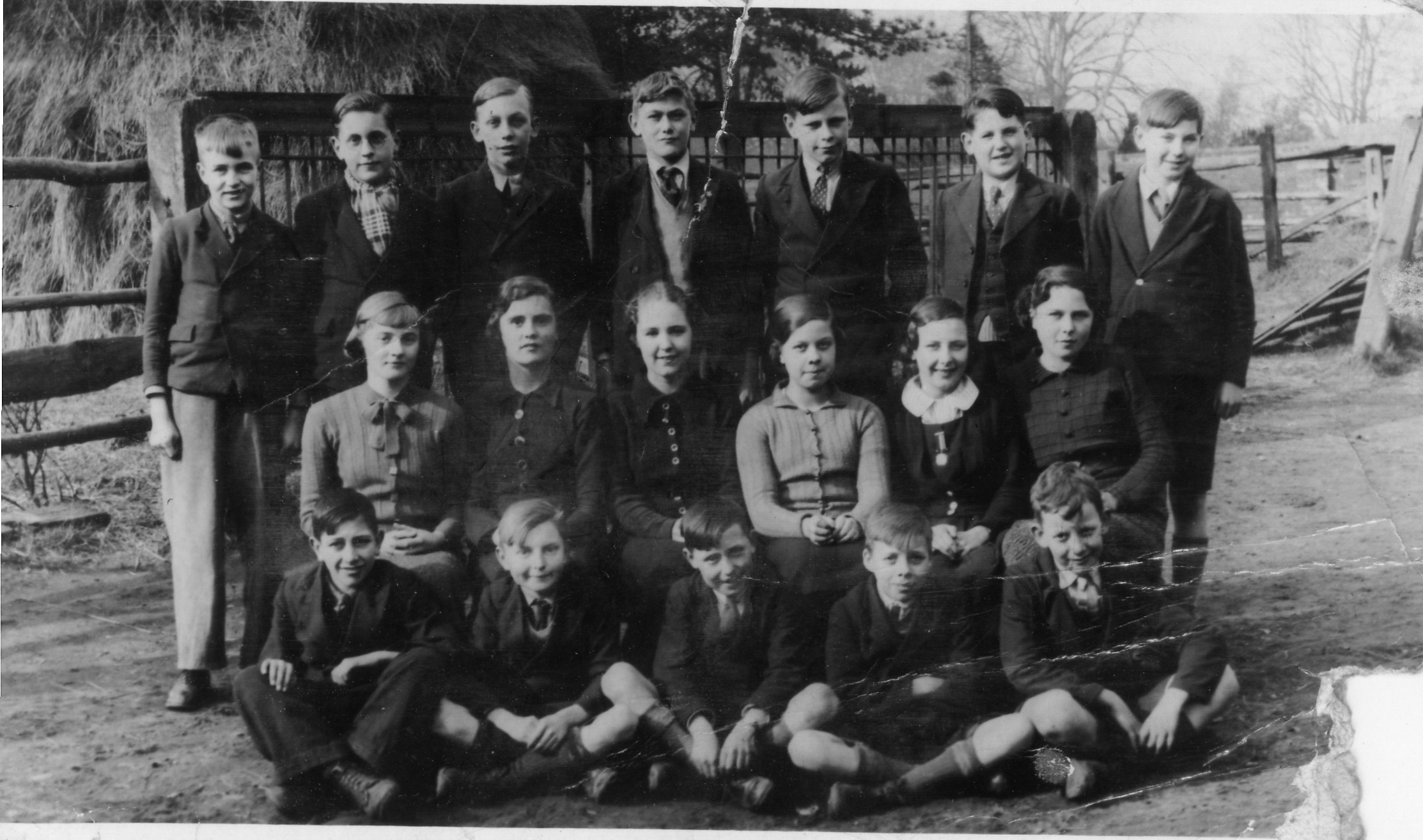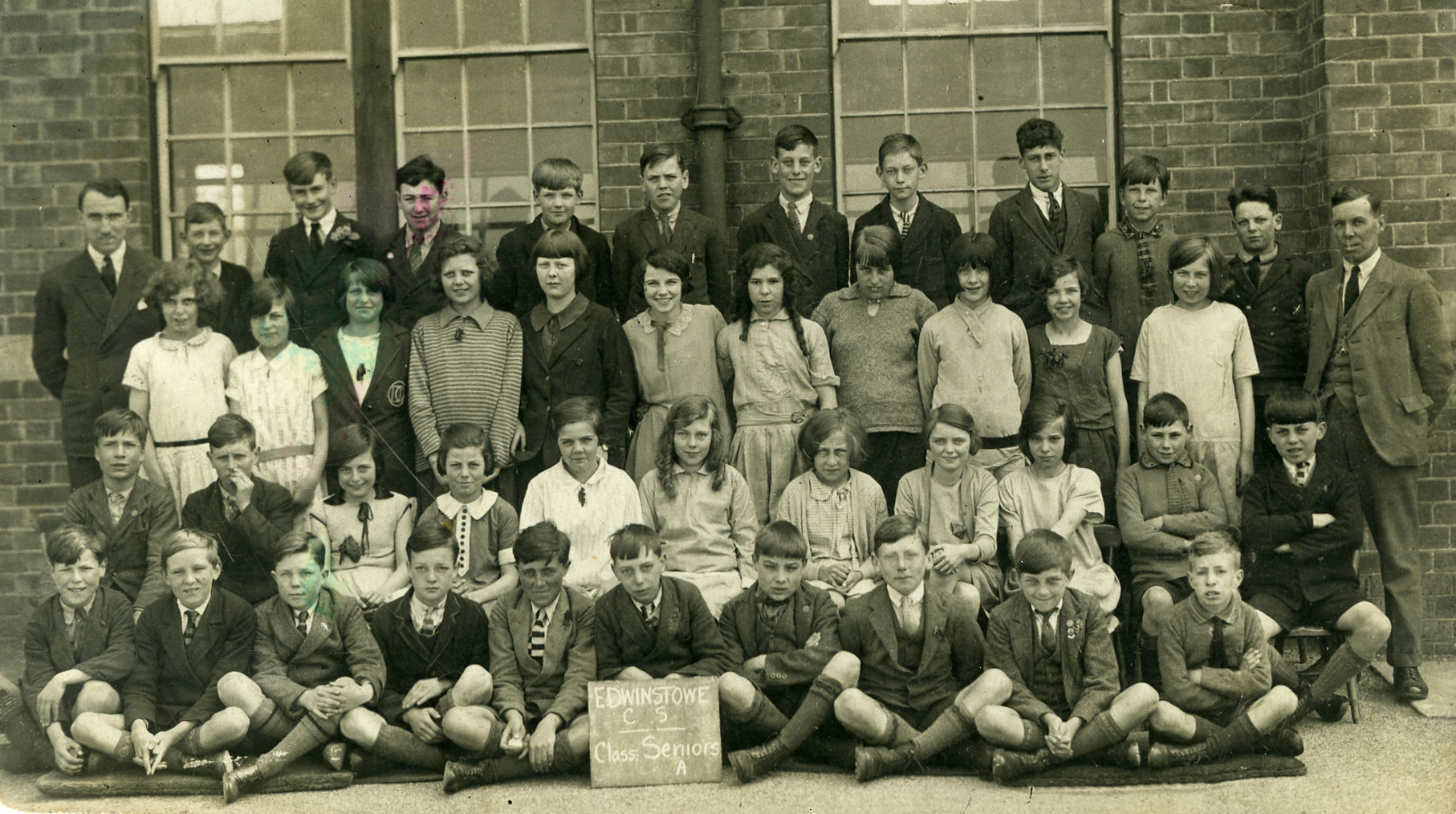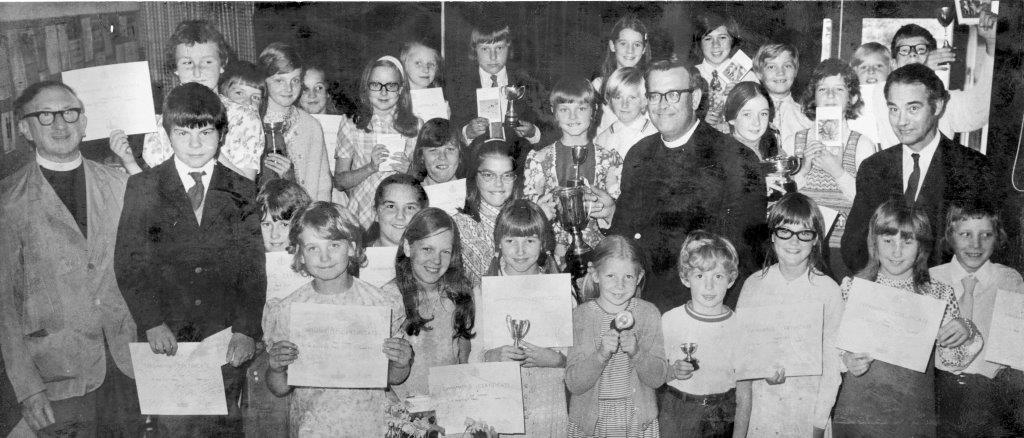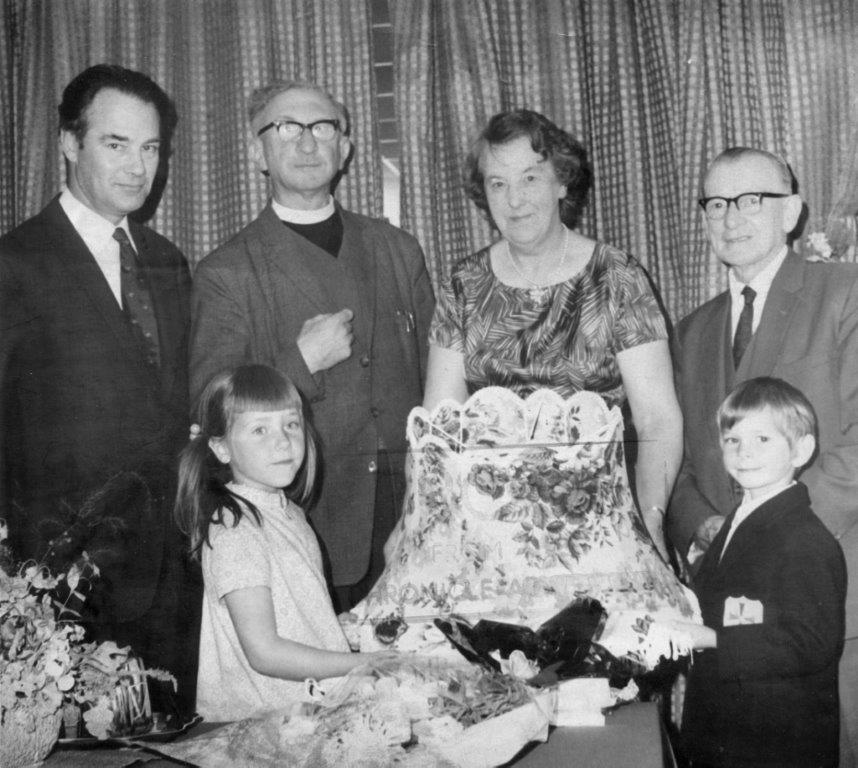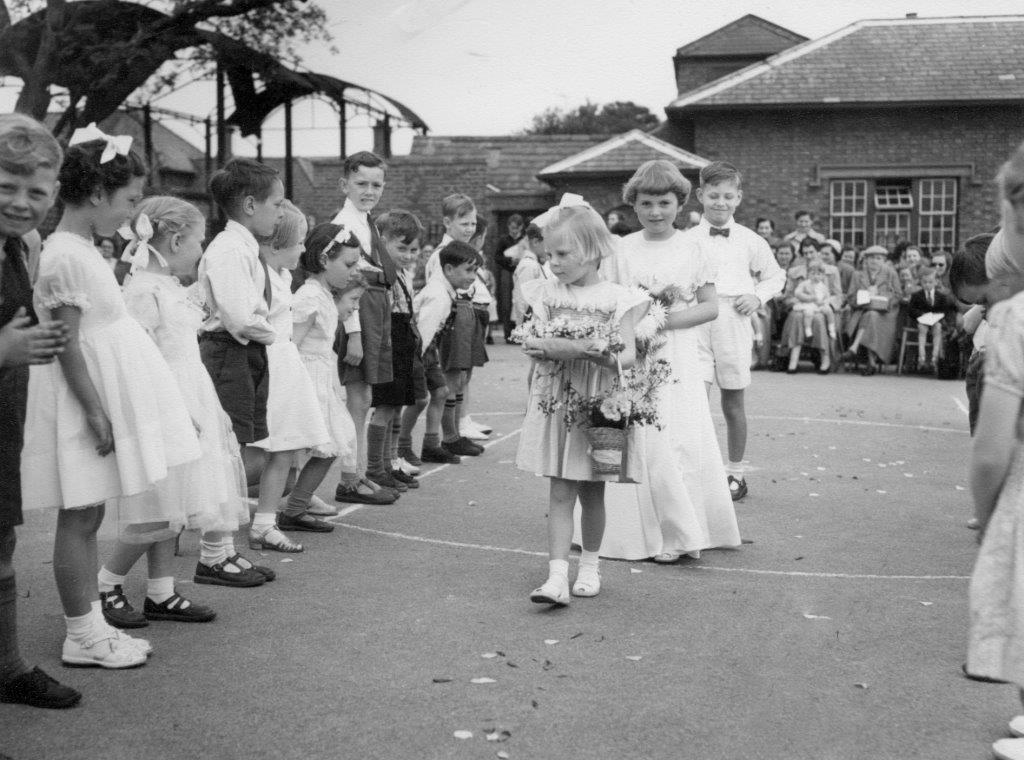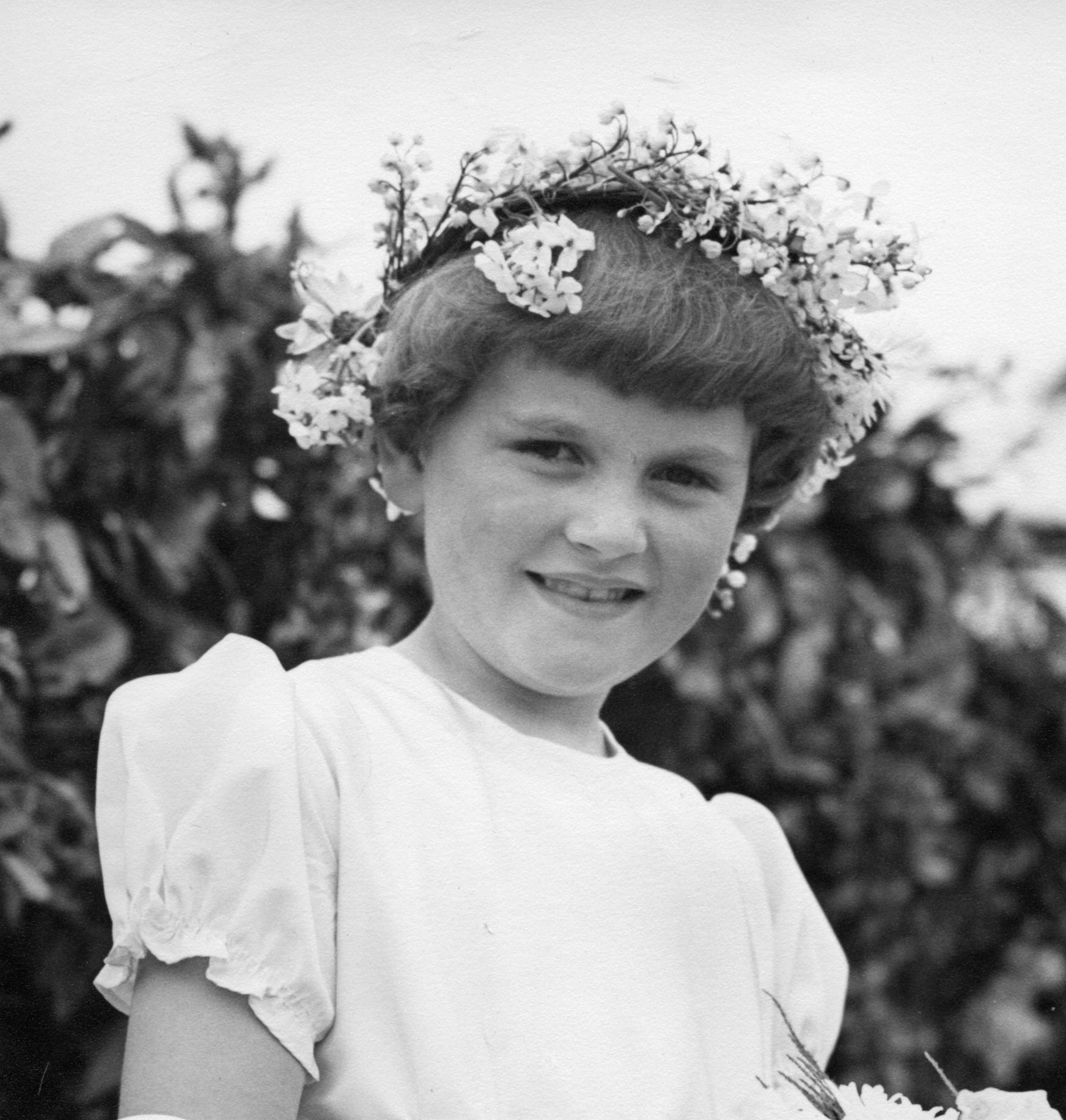During the 15th Century John Waterall, gave a house to the clerk of the parish, rent free, as a reading school, possibly Edwinstowe’s first school.
In 1638, it was reported that the parish clerk, “teacheth but whether he hath a licence or no they know not” A later parish clerk, Michael Emery, in registering the death of Anne Hallam in 1652 added, “my first Masters wife which taught me to spell and read in my childhood”. Only a few picked up a smattering of learning from such sources though this situation improved in the early 18th century.
In 1719, a school started by John Bellamy was in place for the education of eight boys, ‘of poor, honest and religious parents, such as shall be born in the town.’ His Will stated, ‘I give and bequeath the school house in Edwinstowe – 1724.’ It was situated on the site of the War Memorial. Mr. John Hanson was Schoolmaster and parish clerk from 1770 until 1805 when he died. He earned £5 a year which was less than most men of the village earned.
By 1824, the school had closed, as it had become dilapidated. Following a village meeting it was decided to build a new school and appoint a new Schoolmaster. The Earl of Manvers paid for the rebuild of a school house and schoolroom. It opened its doors to children over five years old in 1826.
 A new small Infants’ School was built in 1845. (This is now part of the old school.) Later, the Infants’ School took both older girls and infants. The Earl paid the mistress’s salary of £30 a year and when the Boys’ School was deemed unfit he had a room for the boys built onto the girls’ and Infants’ School. He also paid part of the master’s salary.
A new small Infants’ School was built in 1845. (This is now part of the old school.) Later, the Infants’ School took both older girls and infants. The Earl paid the mistress’s salary of £30 a year and when the Boys’ School was deemed unfit he had a room for the boys built onto the girls’ and Infants’ School. He also paid part of the master’s salary.
Side entrance built in 1845

By 1846 the numbers of each school were as below:
Endowed School (Schoolmaster Mr. Henry Russell) 18 boys
Infants’ School 46 children
Lady H. Bentinck 50 girls
Countess Manvers Girls’ School 10 girls
Also, 30 children attended Dame’s Schools (like ‘Child Minders’) usually for younger children and 58 children went to Ollerton, 2 miles away, with most children walking there. This was very hard on the children in the Winter as they would arrive home at 6 o’clock in the dark.
Also, in the mid 1800s Ashgrove House on West Lane, which later became the vicarage, was a Young Ladies school. Newspaper report,
“ASHGROVE HOUSE, EDWINSTOWE. MRS. and Miss DRACOTT beg to return their sincere thanks for the share of patronage they have received in their Establishment for young Ladies, and also to inform their friends and the public that they will resume their scholastic duties on Tuesday, July 27th.—References are kindly permitted to the Rev. John Gordon, Vicar of Edwinstowe, the Rev R. Pocklington, Vicar of Walesby, the Rev. J. Peatfield, West Bridgeford, and to R. C. Ward, Esq., Ollerton. Edwinstowe, July 10th”
Stamford Mercury 1841
In 1872, William Smith was the Free School master, and parish clerk. The infant school was run by Ann Morley.
1864, the school closed once again, as the Schoolmaster, Mr. Russell was ill. He died in 1866. A local cabinet maker then used the building for his work.
A new school opened in 1867 following a meeting and appeal, where 30 people donated £330. 4s. 4d and additional finances received from the Earl of Manvers. A new Headmaster, Mr. Leslie Manning was appointed. The new school was named Edwinstowe Endowed Parochial School.
 In 1872, the schoolroom built in 1826 was no longer in use. A new school room for boys was added to the Infant School of 1845, which was used as a Girls’ and Infants’ School. The newer building was now used for the boys. Now, there were two separate schools, one for 40 boys taught by Mr. Manning (aged six to sixteen) and another for 60 girls and infants across the road. The Headmistress in 1869 was Miss Annie Moverley, who was a ‘properly’ trained teacher. Within a few years, 120 children attended the schools which now came under Government inspection. The Vicar regularly helped. His wife and daughter taught needlework and knitting.
In 1872, the schoolroom built in 1826 was no longer in use. A new school room for boys was added to the Infant School of 1845, which was used as a Girls’ and Infants’ School. The newer building was now used for the boys. Now, there were two separate schools, one for 40 boys taught by Mr. Manning (aged six to sixteen) and another for 60 girls and infants across the road. The Headmistress in 1869 was Miss Annie Moverley, who was a ‘properly’ trained teacher. Within a few years, 120 children attended the schools which now came under Government inspection. The Vicar regularly helped. His wife and daughter taught needlework and knitting.
Entrance to the 1872 room on the left. The 1893 Infant Room on the right.


Exterior view showing the unusual roof of the infant room – originally a bell hung in the skylight roof. Interior view – although this is a dark photo it shows the metal joists and supports for this almost unique feature.
1872 Extracts from the school Log Book:
- Attendance numbers sometimes dropped due to: Working Scaring birds; Turnip singling; Hop-picking; Harvest; Weeding wheat; Potato crop; Picking fruit and wild raspberries; Pinders Firework Factory.
- Vicar helped with Scripture; Vicar’s wife helped with Reading; Head’s wife helped with Reading and Sewing.
- Two maps swing slate and reading books purchased for use in school.
- 2 girls whose homes are above a distance of 2 miles away from village work for half an hour at needlework at dinner time so they may leave at 3.30 during the dark days.
- Re-opened school after being closed for five weeks because of alterations. Girls unable to write on paper there being no desks in the schoolroom. Introduced Exercise Books for new lessons.

Plan of crossroads where the school was situated 1861
 After another money crisis in 1883, the schools united with a new Head Master, William Curtis, a newly qualified teacher. He was a fine schoolmaster and a man of humanity – he rarely inflicted corporal punishment. He was church choirmaster for 17 years, superintendent of the Sunday School, founder of the Boys’ Brigade, secretary of the newly formed Cooperative Society and several village charities.
After another money crisis in 1883, the schools united with a new Head Master, William Curtis, a newly qualified teacher. He was a fine schoolmaster and a man of humanity – he rarely inflicted corporal punishment. He was church choirmaster for 17 years, superintendent of the Sunday School, founder of the Boys’ Brigade, secretary of the newly formed Cooperative Society and several village charities.
In 1885, a brick partition that divided the two rooms was removed and the whole school was cleaned and painted.
Mr Curtis Head Master C1900

His wife, Elizabeth and children 1910. Later she became a headteacher at Eaton.
In 1887, the infant room was enlarged, new rooms, playground and washbasins were added. Mr. Curtis introduced cookery lessons for girls, geometry/drawing and mapping for boys. All children had basic Science lessons, nature observation walks with land surveying. The children put on operettas in 1886, 1887, 1888 and 1893.

Operetta – ‘Rip Van Winkle
Hayman, Ida and Ivy Rabbit -Twins, Miss Holmes and Mrs. Moore
With the building of the railway to Edwinstowe in 1893, many new children of navies joined the school and a new infants’ room was added.
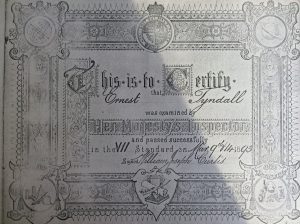
The School’s Log Book shares a little of life during this time including a Scarlet Fever Epidemic:
1894 Nov 5 This noted day could not be passed over by my boys who showed their enthusiasm by letting off fireworks in the playground during the dinner hour, merely I suppose to smell powder and get into trouble which they certainly did.
1897 July 21 Closed School this afternoon without marking Register as the children were to a great extent enticed down the Village Street by a party of tourists who were distributing racing prizes to amuse themselves and children. I often show myself just before afternoon school in the Street to draw the youngsters away from the visitors who swarm here this time of day.
1899 Mar 20 School was closed today as so many children were known to be going to Mansfield by the new line which opens today – LD&EC Railway.
1900 Feb 15 I was obliged to close the school this afternoon owing to the heavy snowstorm and blizzard which raged from morning until evening. It was as much as the long distance boys would do to be able to reach home safely
Mar 7 Major Lombe of Edwinstowe Hall visited school this afternoon to thank the children for subscribing so liberally to the proposed soldiers home at Bisley.
Mar 23 Mrs Curtis will now take charge of Standards i and ii with the assistance of a paid Monitress and the iii Standard will be undertaken partly by my eldest daughter Mabel who is qualifying for Art 68 until she sits for a scholarship exam next Xmas.
Apr 27 When I reached school this afternoon I found about 20 scholars only. All the rest had gone to the “Circus” which unfortunately had arranged for a 2 o’clock performance for children. I did not mark registers therefore. I would have asked the Manager to have made it 3:30 to suit the school arrangements better.
1901 Mar 18 There was quite a sensation caused in this school morning by the arrival of 26 splendid Inverness cape-overcoats for the Clipstone contingent of boys as a present from the Duke of Portland. The Rev Hayman distributed them to the fortunate recipients who gave three hearty cheers for his Grace and the Vicar.
Mar 26 The boys of the IV V VI were invited by Mr J Hill Clerk of Works on Thoresby Estate to visit the Works at the famous Woodyard in the Park for the purpose of seeing the machinery at work. Mr Hill very kindly met us and commencing in the Engine House thoroughly explained the working of the splendid engine and all the various sawing planning boring turning and stone-breaking machines worked by the above engines. The lads took notes as they went along and seemed to thoroughly grasp the value of the latest labour-saving machinery.
July 7 The scarlet fever is spreading very fast and the attendance is falling off considerably
July 12 A notice was received by the Managers this morning from the Medical Officer ordering the school closed until further notice. It re-opened on Sept 30th.
Sept 30 Miss M Curtis has been removed from iii Standard to undertake the Infants Dept… Scarlet Fever reappeared with ‘renewed vigour’ so the school was again closed
1902 Jan 1 Re-opened school this morning with a good attendance. The fever has taken six off our books and several are still in hospital. Such an epidemic has not visited this district for many years according to the testimony of the oldest inhabitants. There is scarcely a house which has not been visited.
Feb 6 The school was again closed by order of the Medical Officer of Health
Apr 1 Reopened school this morning for another trial. The fever still exists in two houses but the Medical Officer is watching closely to prevent any intercourse with other families. In spite of the fearful outbreak of fever which has spread in this village the people as a rule are just as incautious as ever.
Apr 4 Work steadily progressing. I find that Reading, has suffered the most among the boys of the Upper Standards during the long closure
April 22 Mr W Curtis, Head Teacher of this school died after a short illness, I have had nearly 18 years experience of Mr Curtis’ work in the school and I testify to the thoroughness and honesty with which it was done. Mr Curtis was a splendid disciplinarian at the same time he won the affection of the children – the School had never a better master and the Managers a more loyal and devoted official. H T Hayman Chairman (Rev Hayman was the Vicar of St Mary’s Edwinstowe.)
After Mr. Curtis had died, the parishioners paid for a stained-glass window and plaque to be dedicated to him.


Edwinstowe Sunday School Treat September 1914
“Owing to the war it was decided to have a school treat as soon as possible and not attempt to go to the sea. Consequently, the teachers accepted a very kind invitation from Mrs Wright to hold it on the field at Edwinstowe House on Wednesday, August 19th. The children assemblied at the schools at 2:45, marched through the village. 150 children were present along with teachers and helpers. The day was beautifully fine, and for the first part of the programme before tea consisted of games of various sorts and descriptions, including football, cricket, rounders and round games.
Tea was at 4:30. An excellent one was provided by Miss Mitchell, and ample justice was done to it. After tea, sports of varied character took place, including races, long and short and three-legged. A greasy pole and high jumps, the prizes for these being kindly given by Mr T. Hicks, and a tug of war all receiving one or more prizes.
At the conclusion the vicar (Rev. Bond) called the together, round the Union Jacks, where they gave some hearty cheers for Mrs. Wright , their teachers and vicar, and sang Rule Britannia and God Save the King; the proceedings closing with scrambles and sweets, and an interesting teachers’ race, which was won by Mrs Rutty.
We are very grateful to all helpers and to Mrs. Wright for her kind hospitality.”
Acknowledgement Edwinstowe Parish Council Sept. 1914


Mr. George Greaves was appointed the new Headmaster. He started a library, modelling with clay and gardening. The school was modernised in 1925, with lighting, heating and ventilation. The colliery provided the electricity.
Stephen Morley shares in this letter his childhood days in Edwinstowe & life at St. Mary’s
Dear Miss Widdon,
The poem by Mr. George Greaves in the March issue of “The Forest Christian” reminded me that, in the grounds of Lidgett House on Rufford Road at Edwinstowe, there is an oak tree grown from an acorn taken from the Major Oak. It is situated to the left of his main gateway and was planted by one of the Pinder boys to whom there was three.
The Pinders lived there for some time and owned the firework factory higher up the hill. The youngest, Sidney, who probably planted it was a similar age to my father and they were much in one another’s company as boys and youths. The younger sons were killed during the first world war.
Mr. Greaves I remember well. I was in his class for my last 4 years at school. I also took the Collect class on Sunday morning in the morning in the Church Room which I attended as a boy. After the class we usually went to Church. Miss Alice Freeman and Miss Florence Wardale took the infant class in one of the other rooms, after which they also went to Church, but the infants left during the hymn before the sermon. The catechism class on Sunday afternoon was taken by the current curate.
Mr. Greaves retired at the end of September 1933. I remember that because I left school on the same day, together with Elsie Wood. Unfortunately, she died soon afterwards, most probably of tuberculosis which was a scourge of those times.
I am one of the Morley’s of Edwinstowe, being related to both Vera Morley and Sidney Morley distantly. My sister is Mrs. Ruby Anthony, whom you know.
Yours sincerely, Stephen Morley

St Mary’s School 1926
In 1928, there was 212 children attending. As a new Council School had been built 34 ‘new children’ from St. Mary’s were escorted to this new school.


 Council School now King Edwin Primary School c.1930s
Council School now King Edwin Primary School c.1930s

Mrs. Greaves was Headteacher of the infant school at St. Mary’s

St Mary’s School in 1938. Photo was sent by Kathleen Wood (nee Wright) wife of Frank Wright artist.
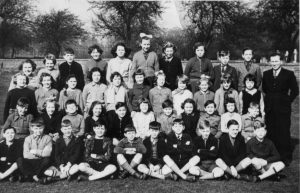
In 1933, Mr. Greaves retired and was replaced by Mr. John Firth who taught until 1952.

St. Marys Youth Club 1959

New St. Mary’s School Opening 1970
 The next development was the building of the Dukeries Comprehensive School at Ollerton in 1964 and the senior children transferred there. More information about this school in the Rufford School section.
The next development was the building of the Dukeries Comprehensive School at Ollerton in 1964 and the senior children transferred there. More information about this school in the Rufford School section.
The Church School was out-of-date so parents and church decided to raise money and build a new school. In 1969, a new modern school near the forest opened with Mr. Michael Jackson, as Headteacher. An official opening took place in 1970. In 2000, a new classroom/Early Learning Unit and disabled access toilet was added. Further information see the St. Mary’s link
The old building, which was condemned was restored as the Village Hall and the playground now contains bungalows and a car park.

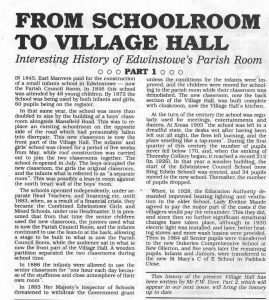

 Edwinstowe Historical Society
Edwinstowe Historical Society


